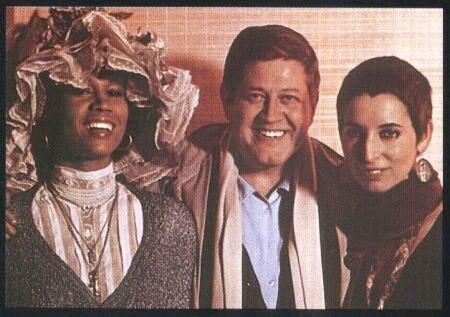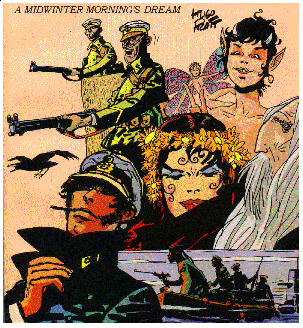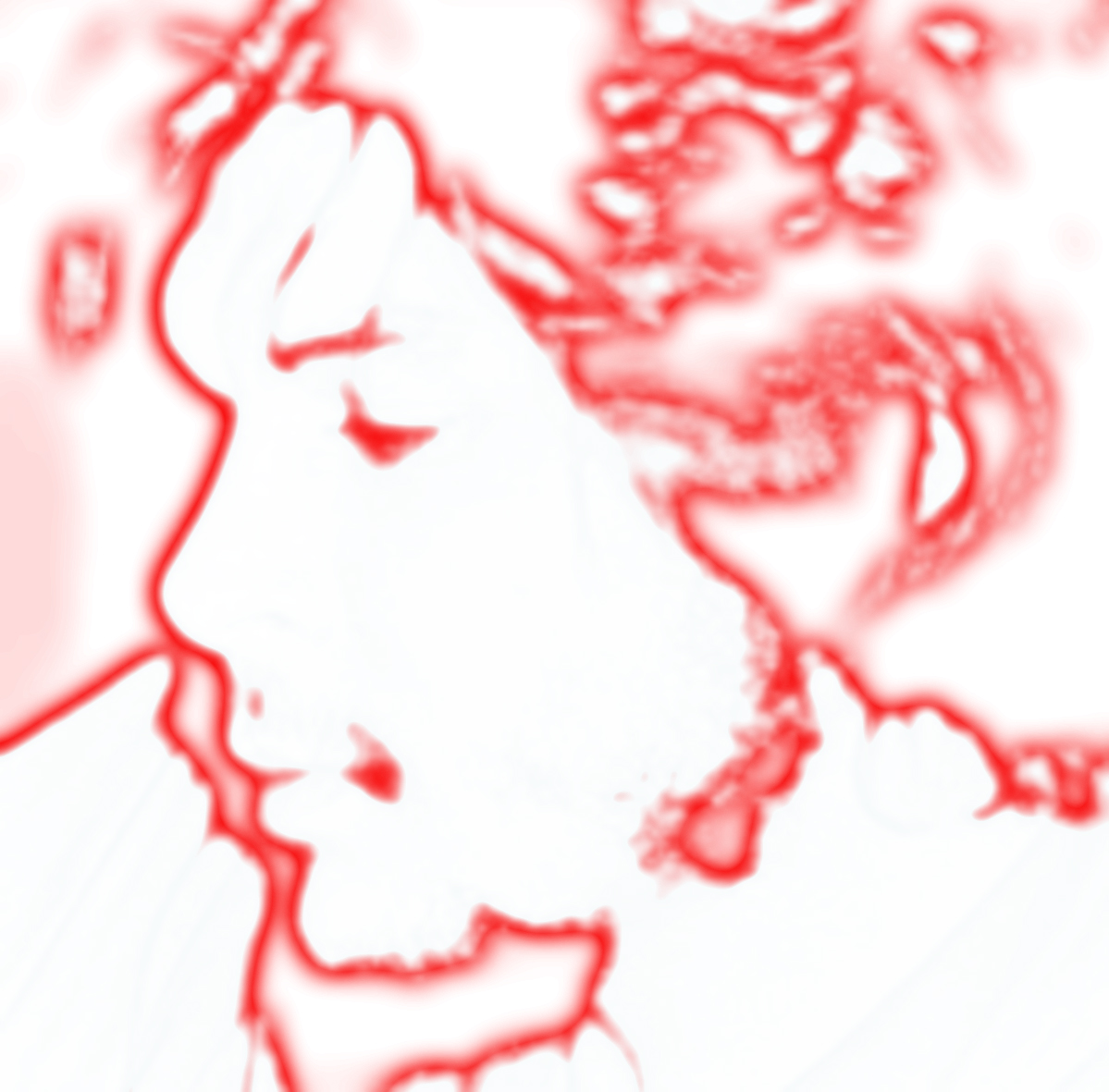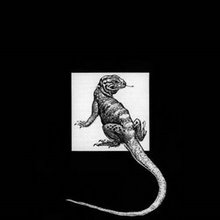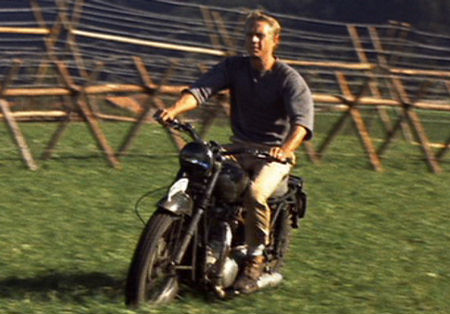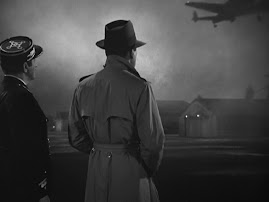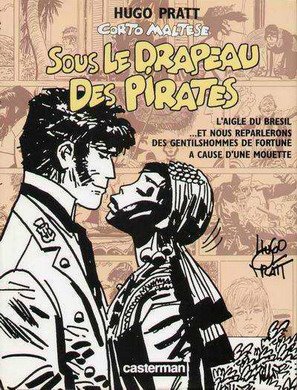
A Corto Maltese Bibliography
by Andy Etris
Irritatingly there are multiple versions of the Corto Maltese albums, depending on whether you are reading in English or another European language. Then there are colorized versions of the stories! In addition the American publisher NBM took considerable liberties in translating the tales (the ones they bothered to translate!) My big beef is that NBM decided to swap around some of the stories so that there is little relationship between the organization of the European and American albums! Where English translations exist, the publisher’s name is given in parenthesis after the title (if not, the original French title).
The Early Years (NBM)
The original French title - La Jeunesse de Corto - is a bit misleading, as the main characters in this adventure seems to be Rasputin and Jack London, rather than Corto. In early 1905, at the end of the Russo-Japanese war, Jack London (then an ambitious war correspondent) gets into a brawl with a Japanese officer. Rasputin is ostensibly a regular soldier in the Russian army, but when a whistle signals the end of the war he choose to disregard it, killing both an enemy officer as well as his own superior - on the dubitous grounds that nobody asked him his opinion! And Corto? As usual, he's more interested in hidden treasures than politics, and in this story we find him daydreaming about the famous gold mines of king Solomon...
Ballad of the Salt Sea (NBM, The Harvill Press)
Between 1913 and 1915, Corto and Rasputin are both employees for the mysterious "Monk", perhaps the last great pirate. From his headquarters at the secret island of Escondida, he controls large areas of the Southern Pacific, to the benefit of the Germans - who, in lack of more trustworthy allies and in dire need of coal supplies, find themselves forced to deal with freebooters and defrocked priests. The Ballad is much more than a tale about modern pirates, however. Above all, it is a great sea epic, with an athosphere reminiscent of Joseph Conrad's novels. The many references in the Ballad to famous maritime tales (such as Melville's Moby Dick, Robinson Crusoe by Daniel Defoe, Coleridge's Rhyme of the Ancient Mariner, the story of Jason and the Argonauts, etc.) clearly demonstrates that Pratt aspires to place his first major work in this particular tradition. The Ballad is also a collective novel: Instead of the "single hero-formula", the narrative portrays a number of characters which are of equal importance. Though many consider the Ballad as the first Corto Maltese adventure, this is only partly true. If there is a principal part in this story, it can perhaps be said to be played by the Pacific Ocean itself - at least the very first sentences in the Ballad appear to suggest this: "I am the Pacific Ocean and I am the largest..."
The Brazilian Eagle (NBM)
This NBM album consists of 4 episodes set in South America's Atlantic coast. In the first episode we find Corto Maltese escaping the tropical heat on the shuttered verandah of Madame Java's pension, when the alcholic former University of Prague Professor Jeremiah Steiner enters. The orphaned Tristan Bantam appears with a mysterious map and discovers that his sister, Morgana, is a pupil of the voodoo priestess Gold Mouth of Bahia, Argentina. There Tristan and Corto rendezvous with Morgana. They continue to Itapoa where they are sent on a mission by Gold Mouth to end the exploitation of native labour by wealthy landowners. The adventures conclude in Brazil.
Banana Conga (NBM)
In 1916 Corto is in Dutch Guyana posting bail for the dipsomaniac Steiner. Together with Tristan Bantam they are pitted against Rasputin and the heirs of pirates in a treasure hunt involving four aces made of whale bones. Then Corto washes up on the shore of a small Caribbean island and receives a head wound from the beautiful Soledad Lokaarth. Steiner consults with South American trader Levi Columbia and tries to help Corto recover his memory using hallucinogenic mushrooms; they travel together in a dream quest for Eldorado. Corto again stumbles into the intrigues of "Gold Mouth" in the episode "Banana Conga" which pits him against agents and double agents of the U.S. government. We also meet the young prostitute Esmeralda, whose mother loved Corto, together with 'bad girl' Venexiana Stevenson.
Voodoo for the President (NBM)
Corto Maltese must once again post bail for the drunken Jeremiah Steiner before sailing to a corrupt Caribbean island republic. There he finds Soledad Lokaarth being tried for voodoo practices by a kangaroo court. In "Fables et Grands-peres", Corto helps a European surgeon find the grandson brought up by the child's other grandfather, an Indian sorcerer and medicine man. In the final story of the NBM version Venexiana Stevenson turns up in Venice in WWI.
A Mid-Winter Morning's Dream (NBM)
Arguably the best of the series. Set in Europe during the war years 1917-1918. In the European version Corto arrives in Venice in the first of six stories; at the behest of Levi Columbia he is seeking a map to the lost mines of El Dorado. In the NBM version we begin in northern Italy where Corto is the moving power behind a plot to recover hidden Albanian gold during the battle of Caporetto. Next Corto is in Dublin after curfew looking for an old friend: an Irish Republican dead at the hands of British counter-insurgency forces. Then he's off to Brittany where he meets Cain Groovesnore in a tale of spying in WWI. More skullduggery is afoot in Great Britain and Faery King Oberon manipulates Corto into saving the Allied high command with the aid of Merlin and Puck. Corto winds up at an Australian aid station on the western front and witnesses the death of the Red Baron, the great German ace of WWI.
Corto Maltese in Africa (NBM)
From the shores of the North Sea to the shores of the Red Sea! This album takes Corto Maltese to the African theaters of the First World War. The story begins in the Yemeni desert where a group of British troops are in Tuban, held prisoner by the Turks. Corto and the Danakil nomad Cush meet there during a mission to rescue a Bedouin petit prince; the pair then travel to Abyssinia where they consult aged sorcerer - or fallen angel? - Shamael, the poison of God, who may be able to resolve a dispute involving two lovers of different religions. Corto winds up in German East Africa where an African secret society of 'leopardmen' helps him avenge the murder of the brother of Captain Slutter (Ballad of the Salt Sea.)
Corto Maltese in Siberia (NBM)
A superb story. This album begins in Corto Maltese's home in Hong Kong; at the behest of a Chinese Secret Society Corto, Rasputin and a Chinese agent roam northern Asia in pursuit of an armored train carrying Imperial Russian gold. Quite a challenge because the train is guarded by Cossack troops of the White Russian dictator Admiral Kolchak! The quest is complicated by the Russian Civil War, with Bolshevik troops fighting White Russians supported by Allied powers and Chinese bandits and warlords looking for a piece of the action. We meet Baron Roman von Ungern-Sternberg, descendant of Teutonic Knights, a White Russian officer who became for a time King of Mongolia, riding at the head of his Cossacks in pursuit of a mad dream of glory. A number of characters comment on the apparent disappearance of Corto at the end of the adventure; however he reappears in 1920 to chat up the (female) Chinese agent! Who is the mysterious She?
Fable of Venice (NBM)
This is a self-conscious tale of intrigue and hermeticism set in the early years of Italian Fascism. The real main character of the story is the city of Venice; we linger in the shadows of its secret courtyards, navigate its canals, gaze from its balconies and leap from its tiled roofs. Freemasonry supplies a great deal of the atmosphere of a story which is very occult, full of esoteric symbols and historical references. We are also treated to a collection of Pratt's magnificent character studies. A personal favorite of mine!
The Golden House of Samarkand (La Maison dorée de Samarkand)
Having left Venice Corto contemplates English Romantics on the roof of the Kawakly Mosque in Rhodes. Chased off by Italian occupiers he winds up in a cabal of Turkish plotters where he discovers he has a doppelganger. Corto recalls that his mother had warned him that meeting one's double is a presentiment of death! It turns out not to be Corto's... He re-unites with the Italian Carabinieri Captain Sorrentino before leaving for the Dervish School of Mawlawiyyah. Corto is seeking the Persian treasure which Alexander the Great hid in Central Asia, but it just so happens Rasputin is in a nearby Turkish prison: The Golden House of Samarkand! Venexiana Stevenson makes a surprise appearance as Corto narrowly escapes death at the hands of Turks, Kurds, and Armenians - he is saved from a Bolshevik firing squad by a phone call from Stalin!
Tango (Y todo a media luz)
Corto Maltese slicks back his hair and dances the tango in this tale of gangsters, gamblers, corrupt cops and persecuted prostitutes. It is 1923 and Corto is in Buenos Aires looking for Louise Brookszowyc, the beautiful Polish immigrant who nursed Corto in 'Fable of Venice'. Louise had travelled to Argentina to work for the "Warsavia", an organization passing itself off as a social service but in reality a white slavery network. Corto meets former acquaintances Esmeralda and Butch Cassidy as he seeks revenge on those responsible for his friend's death.
The Secret Rose (Les Helvétiques / Rosa Alchemica)
This story begins in the Swiss village of Montagnola in 1924. Accompanied by Jeremiah Steiner Corto Maltese has gone to Switzerland to visit the exiled German mystic writer Herman Hesse. Corto meets the Klingsor knight, alias Herman Hesse, alias Wolfram von Eschenbach. The story is dream-like and filled with alchemical and esoteric references, giving the reader some difficulty in following the ins and outs of the plot! Corto meets Death, the Devil, King Kong, Eve, Joan of Arc, and the Marquis de Sade in a mixture of modern and medieval myths. Literary fantasy rather than action adventure.
Mu
Pratt plays with the mythic and fantastic in his final Corto Maltese album. At long last Corto has followed up on the map of Mu first introduced in "The Secret of Tristan Bantam". All of Corto's friends are aboard a ship chartered by Levi Columbia, which has reached the island indicated on Tristan's map. The expedition is menaced by the gang of Black pirate Dandy Roll and Quetzal warriors. Also on the island is downed aviatrix 'Tracy Eberhard' - who falls in love with Rasputin! Soledad Lokaarth, too, finds a mate. Corto passes through a series of tests in order to enter the underground world of the Amazons and save them from their enemies. He learns the secret of the lost world aboard a Chinese junk after his friends abandon Levi Columbia! Not a satisfying ending to this wonderful series...

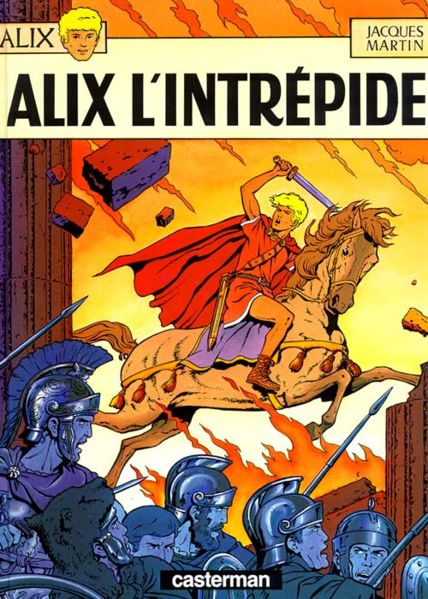 Alix is fearless, generous, and devoted to just causes. Born in Gaul, separated from his parents and sold into slavery, he is later adopted by a Roman noble contemporary to Julius Caesar. This mixed background provides Alix with an identity crisis and divided loyalties, especially in the context of the founding myths of French nationalism revolving around Vercingetorix. In the second adventure Alix is joined by Enak, a slightly younger Egyptian orphan, who remains his constant companion and sounding board. Critics have suggested that Alix and Enak are closet homosexuals, and parodies have overtly depicted them as such. Originally forbidden to have a female companion by the 1949 law governing children's literature, Alix later finds himself entangled with amorous women, but he always hesitates to commit, and the pursuit of social justice provides a pretext for moving on.
Alix is fearless, generous, and devoted to just causes. Born in Gaul, separated from his parents and sold into slavery, he is later adopted by a Roman noble contemporary to Julius Caesar. This mixed background provides Alix with an identity crisis and divided loyalties, especially in the context of the founding myths of French nationalism revolving around Vercingetorix. In the second adventure Alix is joined by Enak, a slightly younger Egyptian orphan, who remains his constant companion and sounding board. Critics have suggested that Alix and Enak are closet homosexuals, and parodies have overtly depicted them as such. Originally forbidden to have a female companion by the 1949 law governing children's literature, Alix later finds himself entangled with amorous women, but he always hesitates to commit, and the pursuit of social justice provides a pretext for moving on.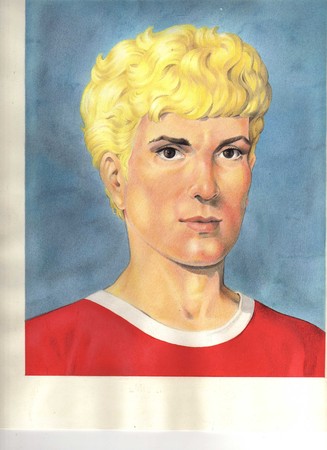 Jacques Martin created the Alix series as one of his earliest heroes, and he continued solo conception, plot, dialogue and illustration for fifty years, even while developing other series such as Lefranc. Due to failing eyesight and advancing age, Martin has since 1998 gradually retired from the series, turning over tasks to various assistants. Rafael Morales became his first assistant, taking charge of the final illustrations with some assistance by Marc Henniquiau, while Martin continued writing the stories and performing the first sketches and layouts.[1]. In 2006, Martin turned over the final writing task to François Maingoval, while still conceiving the main story line in rough draft form. In 2008, Maingoval shifted his attention to a spin-off series (see Alix raconte below), while Patrick Weber assumed the mantle of writing the main Alix series.
Jacques Martin created the Alix series as one of his earliest heroes, and he continued solo conception, plot, dialogue and illustration for fifty years, even while developing other series such as Lefranc. Due to failing eyesight and advancing age, Martin has since 1998 gradually retired from the series, turning over tasks to various assistants. Rafael Morales became his first assistant, taking charge of the final illustrations with some assistance by Marc Henniquiau, while Martin continued writing the stories and performing the first sketches and layouts.[1]. In 2006, Martin turned over the final writing task to François Maingoval, while still conceiving the main story line in rough draft form. In 2008, Maingoval shifted his attention to a spin-off series (see Alix raconte below), while Patrick Weber assumed the mantle of writing the main Alix series.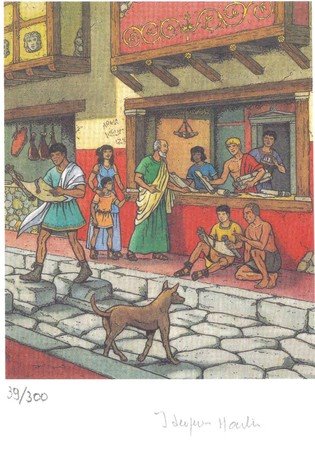 Alix: the hero of the series in the title role, pure of heart, perpetually twenty-five, and wise for his years.
Alix: the hero of the series in the title role, pure of heart, perpetually twenty-five, and wise for his years.
